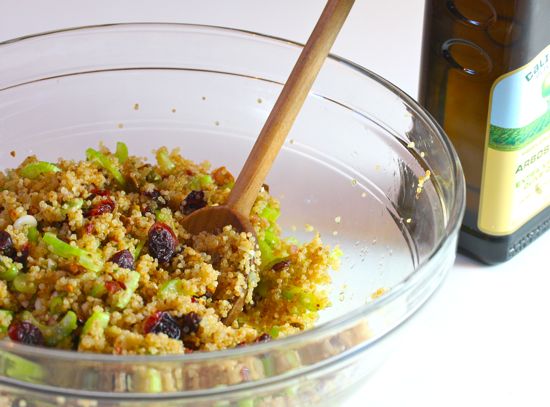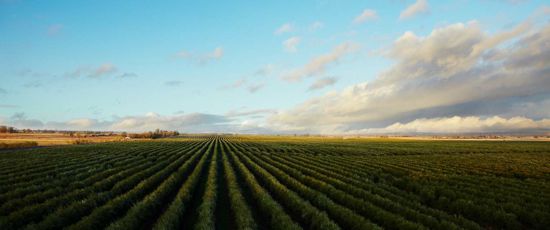California olive oil has held a place of honor in my pantry ever since I attended my first olive oil tasting in 2006 and discovered an emerging community of producers in the Golden State. It’s a key ingredient in this great quinoa, pistachio and cherry salad, which I’ll get to later.
Five years ago, the best-known California oils were produced by small growers raising Tuscan varieties for artisanal oils with high prices. I saved them for special dishes and salad dressings. For everyday cooking, I still relied on supermarket brands of extra virgin oils from Italy.
That changed when I tasted my first mass produced oil from a large California grower that uses modern methods of harvesting and pressing. Here was a fruity, fresh tasting oil at a price low enough for everyday use. Imported oils were banished from my shelves. Most probably don’t meet strict international standards for extra virgin oil, anyway, according to a University of California, Davis study released last year.
My olive oil education took another step forward last week, when I was invited to experience the harvest at California Olive Ranch in Artois, nearly 100 miles north of the state capital in the heart of the Sacramento Valley. The Ranch was a pioneer in the U.S. when it planted its first high-density orchards of semi-dwarf olive trees on 75 acres near Oroville in 1999. It followed a modern Spanish model for planting trees along trellises and harvesting them mechanically, similar to the way wine grapes are handled.
Today, the company is the biggest olive oil producer in the nation and its moderately-priced oils are sold in supermarkets and specialty grocers from coast to coast. It grows Spanish and Greek varieties of olives on three ranches with a total of 5,000 acres in addition to contracting with other farmers for fruit grown on more than 5,000 acres. Its olives go from tree to extra virgin oil in a few hours, thanks to high tech mills. Every truckload is tracked from ranch to bottle.
I jumped at the opportunity to tour the orchards and see those mechanical harvesters in action – not to mention taste oil fresh off the tree. The harvest starts in early October, when the olives begin to hit their peak oil content, and continues into November most years.
From a distance, the Artois orchard looks like rows of neatly trimmed hedges stretching toward the horizon. Only when you get closer is it apparent that the hedges are actually closely planted trees, their tops trimmed flat at about seven feet tall, arranged in rows about five feet apart. Some 650 trees are planted per acre compared with 125 in traditional planting patterns.
Ungainly yellow harvesters, looking for all the world like sheds on wheels, roll up and down the rows at the pace of a brisk walker. As they pass over the rows, the machines squeeze and shake the trees, harvesting all but a few olives without breaking the branches.
As a treat, ranch manager Adam Englehardt offered five other bloggers and me a chance to ride on one of the harvesters. It was noisy, dusty and great fun to watch the olives collect in bins then move up a conveyor belt to be dumped in a trailer traveling alongside in the next row.
“It’s still a pretty new technology and it’s still being refined,” says Englehardt, who notes that only three varieties are suitable for this process now. They’re the Spanish Arbequina and Arbosana varieties and the Greek Koroneiki.
Once they’re picked, the olives are rushed to the nearby mill, where they’re washed, sorted and pressed. The oil emerges from the press in a brilliant green stream before being piped to 55-foot tall stainless steel tanks, where it settles before bottling. It’s never filtered.
Much of the oil is blended into the company’s Everyday California Extra Virgin Olive Oil or the Miller’s Blend, which won best of class in the Armonia Olive Oil competition in Italy. The rest goes into single variety Arbequina or Arbosana oils.
The majority of the olive oil pressed last week won’t see market shelves until next March. The exception is a small Limited Reserve bottling of new oil–the olio nuovo prized by Italians – that will be shipped later this month. In our tasting, the new Arbequina oil was grassy and fresh with a nicely aggressive pungency – that tingling sensation you sometimes get at the back of the throat when you taste extra virgin oil straight up. If you’d like to try it, you can sign up for the waiting list.
My favorite of the standard bottles is the Arbosana, a complex oil with citrus undertones and a peppery kick. It was perfect for the salad, pictured above, that I was tipped to by Kirsten Wanket, the California Olive Ranch’s marketing manager.
The recipe comes from Fran Gage’s “The New American Olive Oil” (Stewart, Tabori & Chang, 2009) and it more than lives up to Kirsten’s billing. Gage toasts the quinoa before cooking, which brings out layers of flavor I’d never before found in the tiny South American grain. My only change was substituting the dried cherries I had on hand for the dried cranberries in the original. Both bring a bright, tart note to a salad that only gets better as it sits in the refrigerator for a day or so.
Serves 4
1/3 cup raw pistachios
1 cup quinoa
1 1/2 cups plus 2 teaspoons water, divided use
3/4 teaspoon kosher salt, divided use
2 teaspoons minced shallots
1 tablespoon sherry vinegar
4 tablespoons extra virgin olive oil
2 stalks celery, sliced
3 green onions, tops removed, sliced
1/4 cup dried sour cherries, coarsely chopped
Preheat oven to 350 degrees and put pistachios in single layer in a small pan. Roast for about 5 minutes, until the nuts begin to smell toasty and turn a light golden brown. Remove from oven, let cool, then chop coarsely.
In a medium skillet, toast quinoa over high heat, shaking or stirring occasionally, until grain begins to brown lightly and crackle like popping corn – about 5 minutes. Scrape quinoa into a medium saucepan with a tightly fitting lid. Stir in 1 1/2 cups water and 1/2 teaspoon salt. Bring to a simmer over medium heat, reduce heat, cover, and let simmer for 15 minutes. Grain should be soft but with a little bite left at center and water should have been absorbed. Turn quinoa into a large bowl and let cool while you make the vinaigrette.
To make vinaigrette: Stir shallots, vinegar and 1/4 teaspoon salt together with a fork in a small bowl or 1-cup measure. Slowly drizzle 2 tablespoons of olive oil into the mixture while beating continuously with the fork to form an emulsion. Beat in 2 teaspoons of water, incorporating well, and then the remaining oil. Season to taste.
Add celery, green onions and cherries to quinoa and stir. Dress with vinaigrette and serve.
Salad keeps well, tightly covered, in the refrigerator overnight. The flavor even improves. Bring to room temperature before serving.
Adapted from “The New American Olive Oil” by Fran Gage




